New Board of Directors at Small Arms Society features skills in archival research, event planning, cultural planning, marketing, and project management
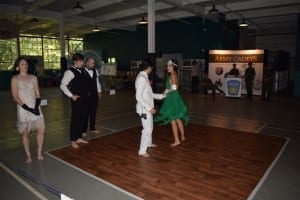
Mississauga-based performance company Frog in Hand presented a special, one-time performance of their latest stage presentation at a Small Arms Doors Open event on Sept. 27, 2014. Frog in Hand creates multi-disciplinary performances in unusual spaces, in this case at the same factory shop floor where weapons were inspected during the Second World War. The view is facing toward the west. Jaan Pill photo
I’ve discussed the Small Arms Society at a recent post, and will talk about the society in more detail later in the current post.
Click here to access the Facebook Page of the Small Arms Society >
On a related topic, I’ve recently had the occasion to think about leadership succession and other key ingredients for success in community-driven projects of all kinds. I have an interest in how community self-organizing works, and I like to help out with the process when I can.
Leadership succession
Community organizations tend to go through life cycles.
1) Some organizations continuously re-invent themselves, and continuously bring in fresh ideas and new generations of leaders.
2) In some organizations, a generation of volunteers does great things, until everyone grows old and the organization folds.
3) Occasionally, a strong local leader with a local organization successfully mobilizes the community to address a pressing local issue and then gets elected to office. In such a scenario, the representation of community interests may continue at the local political level and the community organization that served as the starting point may (depending on the circumstances) tend to fade into the background.
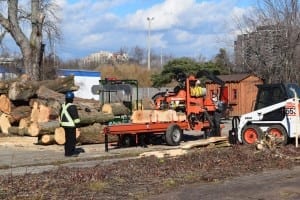
Toronto and Region Conservation Authority worksite near Small Arms Building featuring Sawmill Sid wood repurposing project. A Family Day Event takes place at the worksite on Sunday, Feb. 13, 2016, 12 noon – 3 p.m. Jaan Pill photo
I have encountered variations of all of the above-noted scenarios. Over the past 28 years, I’ve been involved with the founding of four different volunteer associations, one at the local level in Toronto, two at the national level (in Canada and elsewhere), and one at the international level.
Case study of a group that has worked out well
One of the associations that has worked out really well is one that I co-founded in Canada 25 years ago, in 1991 at a meeting in Banff, Alberta. The following factors have contributed to its success:
1) We had a clearly defined purpose for founding the association.
2) The constitution was developed with direct input from the grassroots, with many opportunities for people to debate and discuss their views.
3) We set up an arrangement where each national coordinator (who would be labelled as the president in other associations) served at the most two consecutive terms, in this case of three years per term.
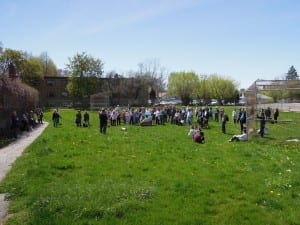
Mike James of Niagara-on-the-Lake (formerly a New Toronto resident) speaks at the former Parkview School during Jane’s Walk in May 6, 2012 at site of Colonel Samuel Smith’s cabin, built in 1797. Jaan Pill photo
4) I served as the coordinator for the first two terms, and a series of coordinators have served in the years that followed.
5) Sometimes I’ve remained closely involved with decision making while at other times I have absented myself from the workings of the board of directors for several years at a time.
6) In particularly challenging situations, for example in a case where it appeared that the board would be unable to find a new coordinator, I have stepped in to help.
7) In recent years, I’ve served a role as a sounding board for a new coordinator, and have been involved in the informal process by which new coordinators have been chosen.
8) From the outset, the organization developed a culture where members feel a strong sense of ownership of the organization, and have a sense that their views are strongly taken into account when decisions are made.
9) Each new generation of leaders has taken the association forward in keeping with changes in the larger society; by way of example, social media applications have become a central element in the work of the association.
10) The strategic plan for the association has been continuously updated, with help from many sources including a board member who has built a great career developing strategic plans for businesses.
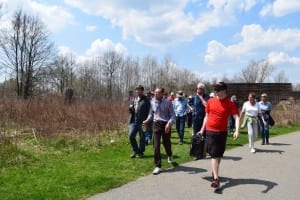
Walking south along Waterfront Trail toward Lake Ontario during May 3, 2015 Jane’s Walk starting at Small Arms in Mississauga. A wooden baffle (see caption at next photo) is visible in the background. Jaan Pill photo
11) Media relations, graphic design, and content-creation volunteers working with the association are in many cases professionals in their respective fields.
Case study of a group where the leadership succession did not work out well
A smaller local group that I co-founded over 25 years ago – in 1988, to be precise – also had had a leadership succession plan in place. However, when I eventually stepped back from keeping the show on the road, it kept on going for several years but it came across an issue that the new leadership could not address.
The issue concerned the need to fill out a form, on an annual basis, to use meeting rooms at a particular facility at no charge. Eventually, the people running the group didn’t get around to filling out the form and the group folded. At that stage in the group’s life, I had moved on to volunteer work at the national level and chose not to return to the group to sort things out.
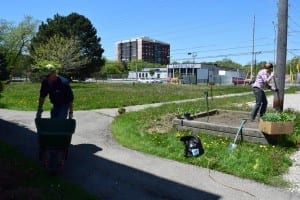
A construction wall (located off the frame to the right) separates the Small Arms Building from the Hanlan Water Project located to the east of it. During a May 3, 2015 Jane’s Walk, City of Mississauga Ward 1 Councillor Jim Tovey led walkers to a visit to the Hanlan site, followed by a walk along the Waterfront Trail to hear a presentation at the Lake Ontario shoreline, by staff from Credit Valley Conservation and Peel Region, about the Lakeview Waterfront Connection Project. Along the way we viewed the wooden baffles, dating back to about 1910, that remain as remnants from the Long Branch Rifle Range. Jaan Pill photo
The national organization (mentioned above) worked out well for many reasons, some of which have to do with my own involvement and some of which have to do with the fact that, with me stepping back from a key leadership role but still available as a resource, other people became the new, key decision makers. It takes some skills for a leader to relinquish the practice of leading, in such a case, but it can readily be done; many people have gone through such transitions.
Over the last couple of decades, I’ve been involved with the process of finding a new national coordinator, once a given coordinator’s term of office was over. In one, exceptional case some years ago, I served as the acting coordinator, to ensure that a leader was in place while the process of finding a new national leader was underway.
I’ve observed similar, temporary arrangements in other national organizations. Sometimes there may be a challenge, involving a transition in leadership – or in some cases a financial or similar crisis – where the help of a veteran leader from the past history of the organization may be necessary.
Culture of an organization
I think it was a real plus – something that warrants celebration – that the public meetings for the launch of a new association in Long Branch in Toronto where I live have been free of non-stop venting. That is a real plus.
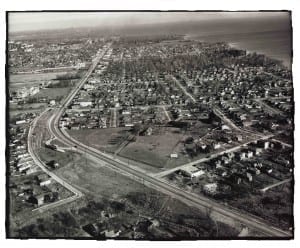
Aerial view looking east along Lake Shore Blvd West from near Long Branch Loop, Ontario Archives Acc 16215, ES1-814, Northway Gestalt Collection. Colonel Samuel Smith’s log cabin, built in 1797, with extensions and siding added over the years, is visible at the centre of the photo. The house was demolished in 1955.
At the most recent organizing meeting that I attended, people stayed on the task at hand, which was to gather input and discuss the draft of the by-laws for the new association. That worked out really well. It’s best to establish a good, strong culture of civility, cooperation, and collaboration right at the founding stage.
Any other approach – that is, to have a situation where the culture does not stress civility – would be difficult to turn around, I would imagine. As a rule, if I’ve ever encountered an organization that stresses a lack of civility, I’ve cleared out. As a volunteer, I only work under good working conditions and I have many choices, with regard to volunteer projects to get involved with. The same is true for many other people, I am sure.
Civility and purpose
Occasionally, it happens that a board of directors votes to remove a board member because of the member’s behaviour.
I strongly support such an approach. If a person engages in outrageous behaviour, whatever that behaviour may be, a board has to act fast, and decisively. Otherwise, a board loses the capacity to function in an atmosphere of civility. In order for a neighbourhood group to have the capacity for rational decision making, there has to be a good procedure in place to discuss matters and arrive at decisions in an organized, consistent, and predictable manner. Without civility, a group demonstrates what people like to call “organizational issues.” If a group has unresolved organizational issues, it won’t be around for long.
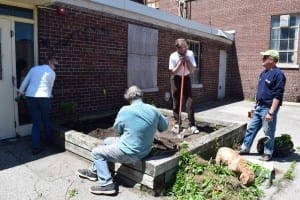
Perennials that enjoy the sunshine have been planted by volunteers on the sunny side of the Small Arms Building such as at the flower bed in the photo. Plants that prefer the shade have been planted at the parts of the building that are shaded. Jaan Pill photo
Confidentiality
I’ve learned over time – in some cases because I’ve overheard conversations myself, at such locations – that coffee shops are not the ideal place to discuss confidential topics related to community initiatives. Better to meet at private homes, or a place like the Food Court at Cloverdale Mall, where a group can talk without having to be concerned about conversations being overheard.
Communications strategy
It’s been my experience that expertise in media relations is an asset for any community organization. As well, I think it’s vital for an organization to communicate with media and other organizations through an established channel of communication, such as a spokesperson or the head of the group. As with many other areas, the more planning that goes into every detail of communications, the better the results. For every task, it’s good to do plenty of planning, to have a clear intention regarding what one seeks to accomplish. It’s best, in my experience, as a leader, member, and observer involved with groups, to leave nothing to chance.
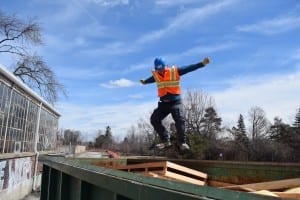
Rick Sirisko of Habitat for Humanity Halton-Mississauga in flight, April 10, 2015 at back of Small Arms Building. Jaan Pill photo
It’s also a great idea to set deadlines, and to meet them, and to start and end meetings on time. That too is part of the culture of an association. The purpose of an association is to plan things and get things done.
As well, content is the key to a successful website and social media strategy. It’s great to have an excellent web design in place, but to make it work, it’s important to have really good content, and to establish a reputation as a source of reliable, accurate, timely, and balanced information.
Social capital and human capital
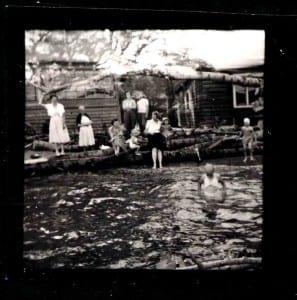
Durance family by Etobicoke Creek around the 1940s near the Lake Ontario shoreline to the southeast of Small Arms Building. Photo credit: Durance family © Durance family and Robert Lansdale
I’ve been reading a bit about the distinction between social capital and human capital. As I understand, social capital refers to a capacity for people to work together in harmony in a community. That’s my rough understanding of the concept. When an association starts off with a culture of civility, it’s starting off with a good store of social capital.
Human capital – again, as I understand these things, in a basic way – refers to the range of valuable skills that a group possesses, as it goes about its task of fulfilling its purpose, whatever that purpose may be. As I understand, we can speak of a complementary relationship between the two forms of capital. (I’ve added, at the end of this post, a reference to a key paper about the topic.)
In this area, as a volunteer and observer, I’ve learned some remarkable things, in recent years. By way of example, some years ago I was involved in a successful effort to keep a local school – the former Parkview School at 85 Forty First Street – in public hands. The school has a large, beautiful playground where local kids like to play after school and in the summer.
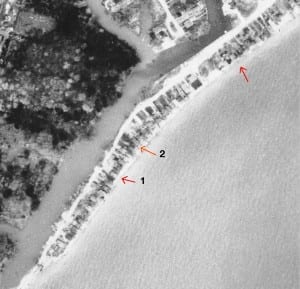
What is now Marie Curtis Park, as it appeared in 1947 (detail, showing cottages on Lake Ontario shoreline) in the decades prior to Hurricane Hazel in 1954. Photo credit: Durance family © Durance family and Robert Lansdale
A letter-writing campaign was the central feature of the community’s effort to save the school from being sold to a developer, who would have built townhouses or condos on the site. When I was first considering how to mobilize the area residents, I thought of organizing a petition.
However, a wise local resident, with experience in how decision makers work, because of a past career as a decision maker, quietly informed me that a letter writing campaign is more effective, because it takes more time, energy, and commitment for a resident to write a letter. When a politician receives scores and scores of letters, that person pays more attention than when a politician receives a petition with scores and scores of signatures.
That aspect of things would never have occurred to me. That brief conversation was a key to the success of the entire project. I had a number of such brief conversations. These conversations, with people wiser and more experienced than I am, were a key ingredient in ensuring the success of the project.
There was also a lot of historical information available, from archival resources, regarding the fact that the school property was an archaeological site. It had been the site where Colonel Samuel Smith had built a log cabin in 1797.
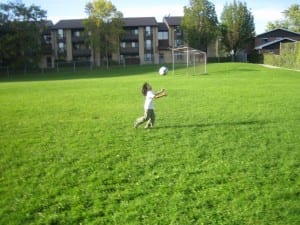
In the background is the hill that’s located on the north side of the site. The Colonel Samuel Smith log cabin was located in an area to the front of the baseball backstop. Jaan Pill photo
From a human capital perspective, the historical information by itself would have meant nothing. It had to be used as content for the letter that we put together, with input from many sources. Many people worked together to draft the letter. That’s how I like to go about my work, when preparing any key bit of communication, of this nature. Putting the content together required expertise in the creation of the content. A person who knows all about the history is not necessarily a person who has expertise in the creation of the content.
So the human capital in this case involved the archival expertise – the capacity to find historical maps and documents. It also involved the expertise in the crafting of content for a letter-writing campaign. I brought that expertise to the task at hand.
As well, and this is critical, we had the benefit of strategic thinking. A person with expertise, in the matters at hand, indicated to me that a letter is better than a petition, if I were to have any hope at all of influencing decision makers. Thus: Historical Evidence; Writing Skills; and Strategic Thinking. These all came into play. Without that synergy of resources, we would not have achieved our goals.
Local case studies – human agency
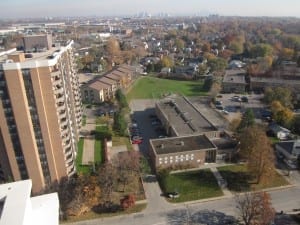
View of Parkview School, photographed from top of Aquaview Condominiums, November 2012. Photo credit: Jaan Pill
Two recent posts about the Small Arms Society are entitled:
TRCA/Sawmill Sid portable sawmilling project is now underway at Small Arms Building in Mississauga
By way of human capital, my sense is that a neighbourhood group needs a wide range of skills in order to achieve success in fulfilling its purpose, whatever that purpose may be. The people who are going to do well as volunteers tend to be people who have achieved some level of success in the wider community. They have marketable skills, of one kind or another. They have about them some sense of agency. That is, they are people who have some influence on events, and have an understanding that as citizens, we are capable of having an influence on what happens in our communities.
I’m a member of the Small Arms Society in Lakeview in Mississauga. I’ve been following the Small Arms Building story for some years.
In recent months, I’ve been learning about the makeup of a new Board of Directors at the Small Arms Society. The board includes both the expertise that relates to archival and historical research, and the expertise that relates to strategic thinking and the conduct of business. That’s an essential combination. All of these skills, working together with a strong leadership, are essential ingredients for success. Just knowing about history – that is highly valuable, but by itself, it is not sufficient. You also need other skills.
In the strategy-related areas, the board members at the Small Arms Society bring with them skills that involve, by way of example:
1) archival research
2) architectural design
3) project management
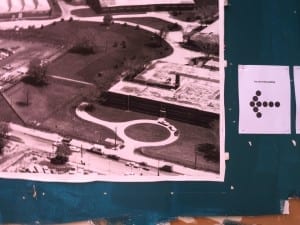
This is an archival photo, displayed at a September 28, 2013 Small Arms Doors Open event, that shows the circular driveway that used to be situated at the front of the Small Arms Building.
4) event planning
5) cultural planning
6) accounting
7) auditing
8) graphic design
9) communications, and
10) marketing
Such skills are essential. They are a key part of the human capital of an association.
Neighbourhood projects involve challenges
A couple of case studies that I’ve been following in recent years underline the fact that community projects frequently entails major challenges.
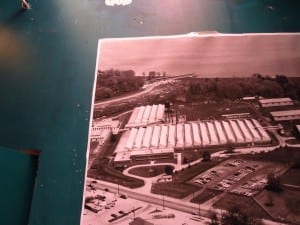
Archival photo from September 28, 2013 Small Arms Doors Open event shows the munitions plant, located east of the Small Arms Building, before it was torn down. The one structure that now remains is the water tower visible in the centre-left area of the photo.
The subtext, as I see it, for such stories is that strategic thinking, and expertise of the kind listed for the Small Arms Society, is absolutely essential if any progress is to be made in addressing challenges facing a given community. Among other things, expertise related to development and implementation of a strategic plan, for any community-driven project, is a necessary condition for success.
And in some cases, if the project does not succeed the first time, it’s great to learn from that experience and to have another go at it, if at all possible, based upon some other approach that increases the probability of a successful outcome.
Click on the photos to enlarge them; click again to enlarge them further
Update
A key resource regarding social capital and its relationship to human capital, as I’ve learned, is a paper entitled Social Capital in the Creation of Human Capital by James S. Coleman (1988) in the The American Journal of Sociology 94, S95-S120.
Click here to access a PDF version of the paper >

Leave a Reply
Want to join the discussion?Feel free to contribute!